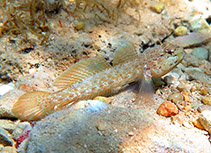| Family: |
Gobiidae (Gobies), subfamily: Gobiinae |
| Max. size: |
10 cm TL (male/unsexed) |
| Environment: |
demersal; marine; depth range 1 - 8 m |
| Distribution: |
Mediterranean Sea: eastern half of the Mediterranean Sea, from the Adriatic to the Aegean Sea, and in the Black Sea and Sea of Marmara. All previous records outside this area are most likely for Gobius incognitus Kovačić & Sanda, 2016 (Ref. 110727).
129796 |
| Diagnosis: |
Dorsal spines (total): 7-7; Dorsal soft rays (total): 14-14; Anal spines: 1-1; Anal soft rays: 13-14. This species is distinguished from its congeners by the following combination of characters: LL 51-55; predorsal scales 20-25; opercle naked (rarely with 2-4 scales visible); pectoral-fin rays 17-18; free tips on 3 upper pectoral rays moderately developed and the first ray shorter than half of the entire ray length; complete pelvic fin disc, its anterior membrane without lateral lobes; anterior oculoscapular canal with pore 'alpha' at rear of orbit; oculoscapular row x1 is not extending forwards to pore ß; suborbital row d is continuous; eye diameter 0.82-1.04 in snout length; there are 2 rows of elongated dots on the cheek and without dots between the middle of the cheek, the lower row starting anteriorly at the angle of mouth and going backwards across the cheek and opercle to the pectoral fin base, the upper row starting at upper lips, going posterodorsally to touch ventral margin of eye and continuing behind eye; upper mark on the pectoral fin single or doubled, reaching downwards to 6th - 7th rays counting from upper end (Ref. 110727). |
| Biology: |
This species occurs on all kinds of rocky substrata: gravel, cobbles, boulders and bedrock, but on sand only when it is mixed with the hard substratum, thus, never on pure sand. The substratum was bare or covered with short thallus algae and no other biocover in the habitat were recorded (Ref. 110727). |
| IUCN Red List Status: |
Least Concern (LC); Date assessed: 15 November 2007 Ref. (130435)
|
| Threat to humans: |
harmless |
Source and more info: www.fishbase.org. For personal, classroom, and other internal use only. Not for publication.
